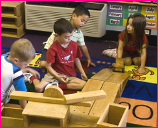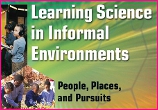Posted on August 16th, 2010 by Jaimie Schock
 Early college high-school programs — a.k.a., dual-enrollment programs — are growing in popularity. The programs allow high schoolers to take college courses, and earn college credits, while still in high school. Historically, they were geared toward high-achieving students to keep them from getting bored. But, many are now aimed at low-income students at risk of dropping out.
Early college high-school programs — a.k.a., dual-enrollment programs — are growing in popularity. The programs allow high schoolers to take college courses, and earn college credits, while still in high school. Historically, they were geared toward high-achieving students to keep them from getting bored. But, many are now aimed at low-income students at risk of dropping out.
Read More
Filed under: K-12 Education News | Comments Off on Dual Enrollment May Help At-Risk Students
Tags: College, Education Policy, Grades 9-12, Research on Learning
Posted on August 16th, 2010 by Jaimie Schock
 So far, around 35 states have adopted the Common Core K-12 academic standards written by the National Governor’s Association and the Council of Chief State School Officials. But, will these standards be better than the statewide versions? Experts disagree, and it may be too soon to tell.
So far, around 35 states have adopted the Common Core K-12 academic standards written by the National Governor’s Association and the Council of Chief State School Officials. But, will these standards be better than the statewide versions? Experts disagree, and it may be too soon to tell.
Read More
Filed under: K-12 Education News | Comments Off on Jury’s Out on the New Standards
Tags: Education Policy, Public Policy, Research on Learning
Posted on August 2nd, 2010 by ASEE
 With three months off in the summer, American students suffer a learning loss — and that’s particularly true of low-income students, who have few options for productive activities. With all U.S. students losing out to their international peers, engaging and fun summer programs may be the answer.
With three months off in the summer, American students suffer a learning loss — and that’s particularly true of low-income students, who have few options for productive activities. With all U.S. students losing out to their international peers, engaging and fun summer programs may be the answer.
Read More
Filed under: K-12 Education News | Comments Off on Summer’s Damaging Effect on Learning
Tags: Education Policy, Public Policy, Research on Learning
Posted on August 2nd, 2010 by ASEE
 A new Harvard study finds that students who had strong teachers when they started school reaped benefits later on. More went on to college, and they earned more than their peers whose kindergarten teachers were mediocre. The study followed a cohort of 12,000 Tennessee students from the 1980s who are now around 30.
A new Harvard study finds that students who had strong teachers when they started school reaped benefits later on. More went on to college, and they earned more than their peers whose kindergarten teachers were mediocre. The study followed a cohort of 12,000 Tennessee students from the 1980s who are now around 30.
Read More
Filed under: K-12 Education News | Comments Off on Quality Kindergarten Influences Later Education
Tags: Grades Pre K-2, Research on Learning, Teachers
Posted on August 2nd, 2010 by Jaimie Schock
 A series of Workshops was organized by the Center for the Study of Mathematics Curriculum to focus on STEM learning design for young students and adolescents. This report provides a summary of the ideas generated by workshop participants and offered to the STEM instructional design community and to agencies that fund this work.
A series of Workshops was organized by the Center for the Study of Mathematics Curriculum to focus on STEM learning design for young students and adolescents. This report provides a summary of the ideas generated by workshop participants and offered to the STEM instructional design community and to agencies that fund this work.
Read More
Filed under: Web Resources | Comments Off on Report: STEM Teacher Workshops
Tags: Research on Learning, Teacher Training, Web Resources
Posted on August 1st, 2010 by Jaimie Schock
 The National Science Resources Center (NSRC) was established in 1985 by the Smithsonian Institution and the National Academies. Its mission is to improve the learning and teaching of science for all students in the United States and throughout the world. It provides listings of regional science centers, museums, science websites and other resources; information on how to participate in programs to improve science education; and NSRC internships.
The National Science Resources Center (NSRC) was established in 1985 by the Smithsonian Institution and the National Academies. Its mission is to improve the learning and teaching of science for all students in the United States and throughout the world. It provides listings of regional science centers, museums, science websites and other resources; information on how to participate in programs to improve science education; and NSRC internships.
Read More
Filed under: Web Resources | Comments Off on Website: National Science Resources Center
Tags: Internet Resources, Internships, Outreach for Schools, Research on Learning, Web Resources, Website
Posted on July 5th, 2010 by ASEE
 High school graduates from low- to middle-income families are finding it harder to enroll in four-year, public universities because the costs of attending the schools are rising well beyond what federal, state, and institutional grants will cover, the Department of Education reports.
High school graduates from low- to middle-income families are finding it harder to enroll in four-year, public universities because the costs of attending the schools are rising well beyond what federal, state, and institutional grants will cover, the Department of Education reports.
Read More
Filed under: K-12 Education News | Comments Off on Four-year College Out of Reach for Many
Tags: College, Education Policy, Public Policy, Research on Learning
Posted on June 7th, 2010 by Jaimie Schock
 The National Academies Press has published a several hundred-page paper called “Learning Science in Informal Environments: People, Places, and Pursuits” (2009). It explores the various facets of science learning outside the classroom and uses research to determine which approaches are most effective. The Committee on Learning Science in Informal Environments was established to examine the potential of non-school settings for science learning.
The National Academies Press has published a several hundred-page paper called “Learning Science in Informal Environments: People, Places, and Pursuits” (2009). It explores the various facets of science learning outside the classroom and uses research to determine which approaches are most effective. The Committee on Learning Science in Informal Environments was established to examine the potential of non-school settings for science learning.
Read More
Filed under: Web Resources | Comments Off on Publication: Research on Informal Learning
Tags: Internet Resources, Museums, National Academies of Sciences, Publication, Research on Learning, Web Resources
Posted on June 7th, 2010 by Jaimie Schock
 If you’re young, gifted, and male, will your talents be overlooked? In New York City, boys comprise 51 percent of the student population; but in the city’s gifted kindergarten classes, fifty-six percent of the students are female, the New York Times reports. While boys have long lagged behind girls in high school graduation rates and college enrollment, educators fear that this new finding may suggest that gender disparity starts at a very early age, according to the Times.
If you’re young, gifted, and male, will your talents be overlooked? In New York City, boys comprise 51 percent of the student population; but in the city’s gifted kindergarten classes, fifty-six percent of the students are female, the New York Times reports. While boys have long lagged behind girls in high school graduation rates and college enrollment, educators fear that this new finding may suggest that gender disparity starts at a very early age, according to the Times.
Read More
Filed under: K-12 Education News | Comments Off on Young, Gifted–and Not Male?
Tags: Education Policy, Elementary Education, Girls Education, Research on Learning
 Early college high-school programs — a.k.a., dual-enrollment programs — are growing in popularity. The programs allow high schoolers to take college courses, and earn college credits, while still in high school. Historically, they were geared toward high-achieving students to keep them from getting bored. But, many are now aimed at low-income students at risk of dropping out.
Early college high-school programs — a.k.a., dual-enrollment programs — are growing in popularity. The programs allow high schoolers to take college courses, and earn college credits, while still in high school. Historically, they were geared toward high-achieving students to keep them from getting bored. But, many are now aimed at low-income students at risk of dropping out.








 So far, around 35 states have adopted the Common Core K-12 academic standards written by the National Governor’s Association and the Council of Chief State School Officials. But, will these standards be better than the statewide versions? Experts disagree, and it may be too soon to tell.
So far, around 35 states have adopted the Common Core K-12 academic standards written by the National Governor’s Association and the Council of Chief State School Officials. But, will these standards be better than the statewide versions? Experts disagree, and it may be too soon to tell. With three months off in the summer, American students suffer a learning loss — and that’s particularly true of low-income students, who have few options for productive activities. With all U.S. students losing out to their international peers, engaging and fun summer programs may be the answer.
With three months off in the summer, American students suffer a learning loss — and that’s particularly true of low-income students, who have few options for productive activities. With all U.S. students losing out to their international peers, engaging and fun summer programs may be the answer. A new Harvard study finds that students who had strong teachers when they started school reaped benefits later on. More went on to college, and they earned more than their peers whose kindergarten teachers were mediocre. The study followed a cohort of 12,000 Tennessee students from the 1980s who are now around 30.
A new Harvard study finds that students who had strong teachers when they started school reaped benefits later on. More went on to college, and they earned more than their peers whose kindergarten teachers were mediocre. The study followed a cohort of 12,000 Tennessee students from the 1980s who are now around 30. A series of Workshops was organized by the
A series of Workshops was organized by the  The National Science Resources Center (NSRC) was established in 1985 by the Smithsonian Institution and the National Academies. Its mission is to improve the learning and teaching of science for all students in the United States and throughout the world. It provides listings of regional science centers, museums, science websites and other resources; information on how to participate in programs to improve science education; and NSRC internships.
The National Science Resources Center (NSRC) was established in 1985 by the Smithsonian Institution and the National Academies. Its mission is to improve the learning and teaching of science for all students in the United States and throughout the world. It provides listings of regional science centers, museums, science websites and other resources; information on how to participate in programs to improve science education; and NSRC internships. High school graduates from low- to middle-income families are finding it harder to enroll in four-year, public universities because the costs of attending the schools are rising well beyond what federal, state, and institutional grants will cover, the Department of Education reports.
High school graduates from low- to middle-income families are finding it harder to enroll in four-year, public universities because the costs of attending the schools are rising well beyond what federal, state, and institutional grants will cover, the Department of Education reports.  The National Academies Press has published a several hundred-page paper called “
The National Academies Press has published a several hundred-page paper called “ If you’re young, gifted, and male, will your talents be overlooked? In New York City, boys comprise 51 percent of the student population; but in the city’s gifted kindergarten classes, fifty-six percent of the students are female, the New York Times reports. While boys have long lagged behind girls in high school graduation rates and college enrollment, educators fear that this new finding may suggest that gender disparity starts at a very early age, according to the Times.
If you’re young, gifted, and male, will your talents be overlooked? In New York City, boys comprise 51 percent of the student population; but in the city’s gifted kindergarten classes, fifty-six percent of the students are female, the New York Times reports. While boys have long lagged behind girls in high school graduation rates and college enrollment, educators fear that this new finding may suggest that gender disparity starts at a very early age, according to the Times.